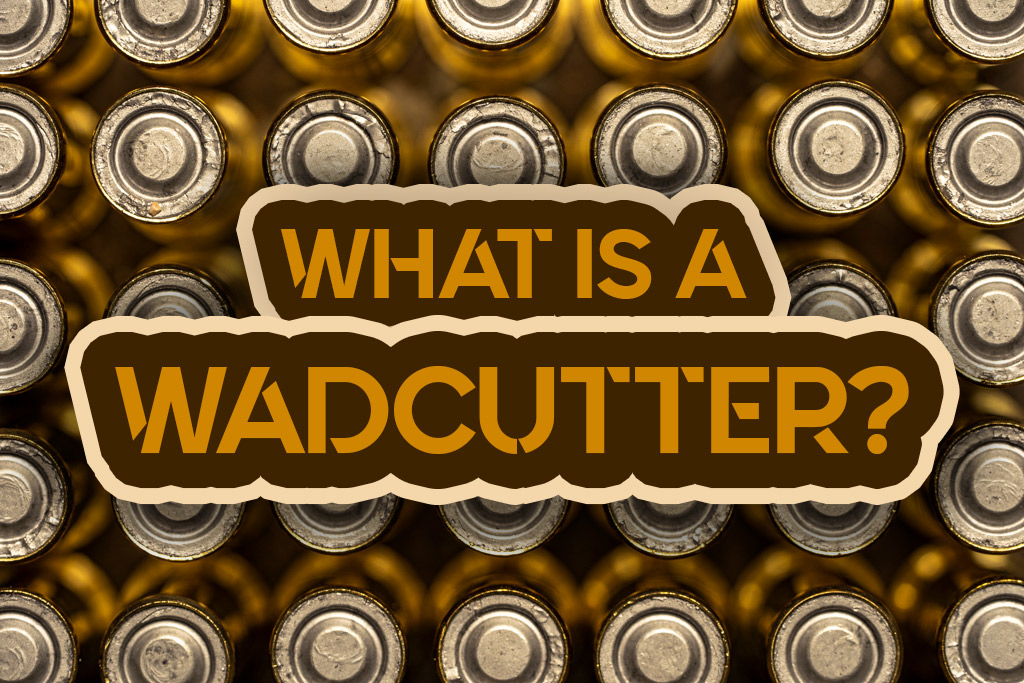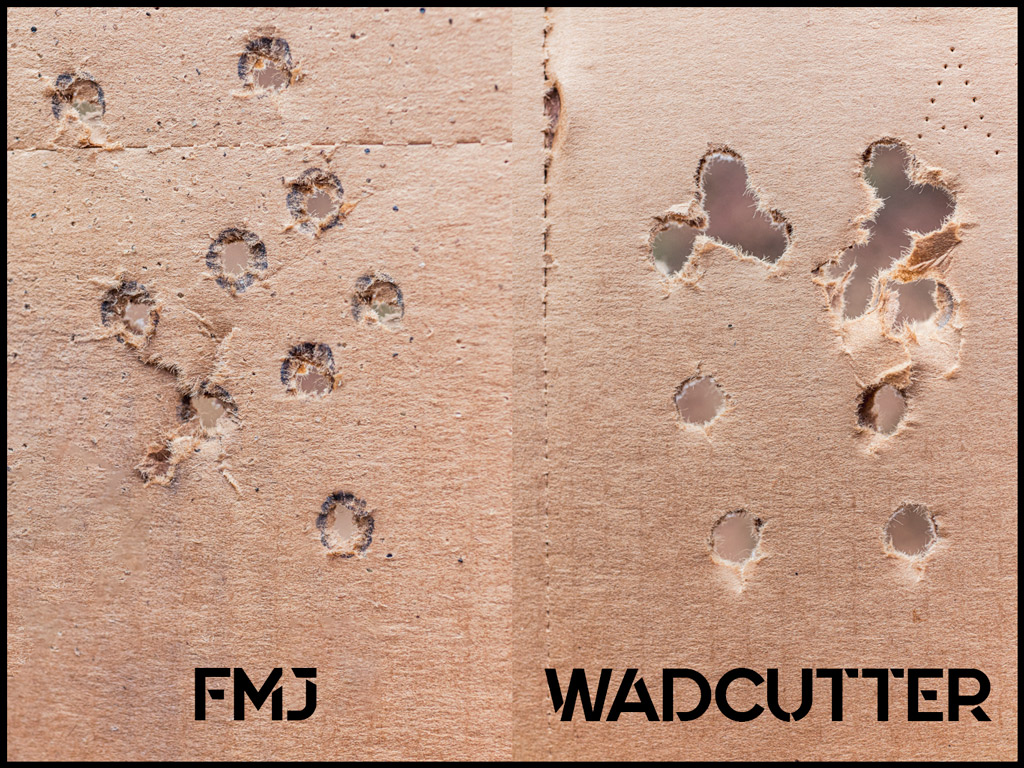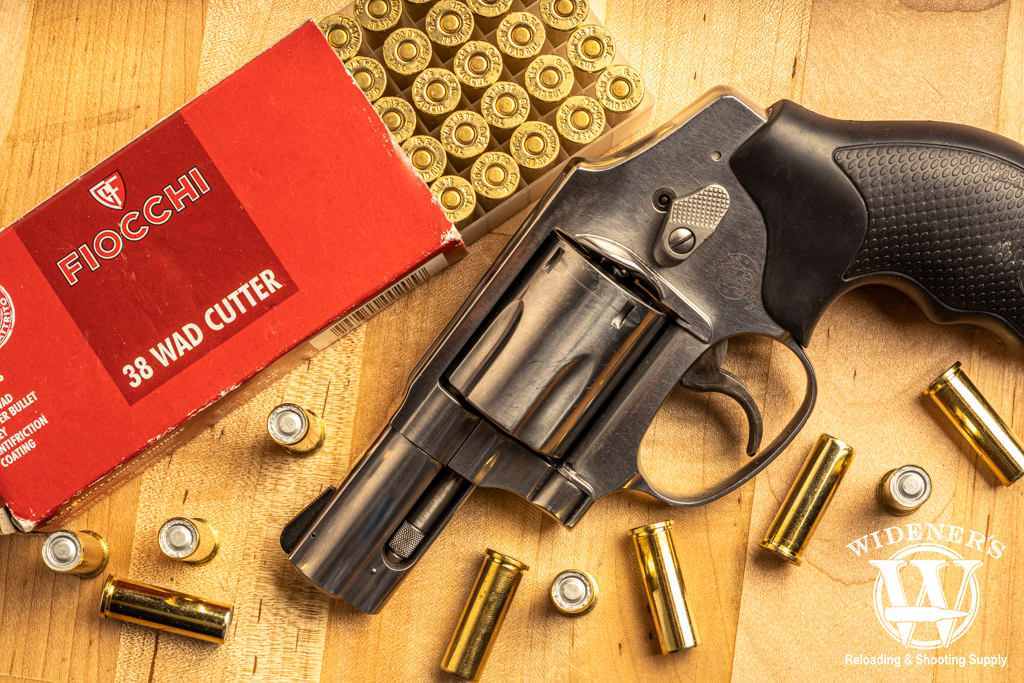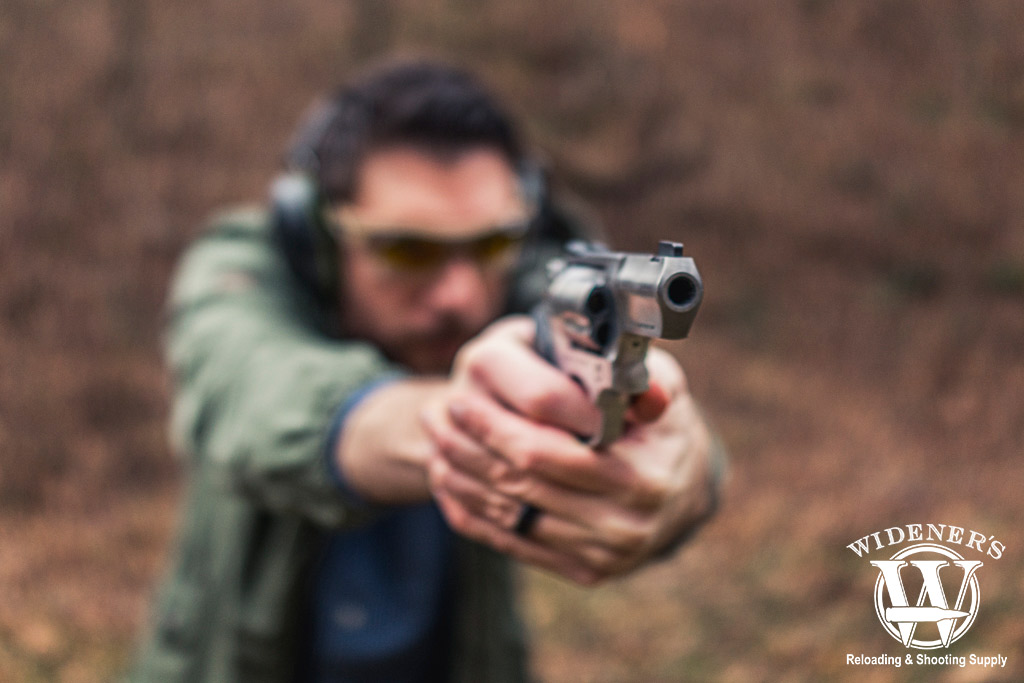

A wadcutter is a cylindrical bullet you’ll often find in revolver cartridges. It is made of pure lead and lacks a gilding metal jacket. Shooters most commonly use wadcutters with paper targets during practice and competition. They can also have self-defense applications.
Wadcutter For Target Practice?

Full metal jacket bullets tear targets as they pass through, while wadcutters punch circular holes in them.
A wadcutter’s broad, circular nose profile acts just like a hole punch when it strikes paper at high velocity. The hole a wadcutter stamps through paper is very clean. This keeps the target in better condition. It also makes it easier for the shooter to see how closely they have grouped their shots.
A conventional full metal jacket (FMJ) bullet has a round nose profile. This nose will tear a ragged hole through a sheet of paper. Group FMJ bullets tightly enough in a paper target. It becomes impossible to tell each bullet hole apart.
Revolver Ammo Options
A semi-automatic firearm automatically loads a new cartridge after extracting the previously fired cartridge’s empty case from the chamber. A semi-auto firearm generally feeds cartridges more reliably if they have bullets with (A) metal jackets, and (B) sloping nose profiles. This is why shooters nearly exclusively fire FMJ ammo for target practice with semi-auto firearms.
In contrast to a semi-auto, a revolver lacks any sort of feeding mechanism. To reload a revolver, the shooter must open the cylinder. Then, you must eject the empty cases by hand. You can then load new cartridges into each chamber of the cylinder. Because the shooter reloads the revolver by hand (or with the aid of a speedloader or moon clip), it does not affect feeding if the ammo is loaded with lead, unjacketed wadcutters which are seated flush with the case mouth or protruding beyond it.
In short, we use the wadcutter for revolver cartridges because only revolvers can load wadcutter ammo. (With some exceptions: You can modify semi-automatic handguns so they will feed wadcutter ammo more reliably. Lever-action rifles can fire wadcutter ammo as well.)
Wadcutter For Self-Defense?

Wadcutter bullets are good at punching holes in things. They don’t get clogged when passing through barriers like some self-defense ammo.
To appreciate why some use wadcutter bullets for self-defense, you must first understand the effect a firearm’s barrel length has on its ammo’s performance.
A cartridge fires its bullet when ignition lights its propellant. Hot, pressurized propellant gasses push the bullet down the barrel, making it go faster and faster until it exits the muzzle. A longer barrel thus gives the propellant gasses more time to transfer their energy to the bullet; conversely, a shorter barrel gives propellant gasses less time to do the same. This explains why a certain cartridge generates a much higher muzzle velocity when you fire it from a rifle as opposed to a handgun.
Revolver Types
Snubnosed revolvers, made for easy concealment, have extremely short barrels. Because of this, cartridges fired out of snub noses achieve relatively low muzzle velocities. This is why a hollow point bullet, which delivers terminal expansion as its nose cavity fills with pressurized soft tissue, may not hit its target with the energy required to trigger terminal expansion if it is fired out of a snub nose. (Although some hollow-point bullets are in fact designed specifically for short-barreled revolvers.)
The wadcutter, however, does not need to expand in order to deal a great deal of damage to soft tissue. Its flat nose profile ends at a sharp 90-degree angle. It effectively punches a wide hole through flesh just like it would through a sheet of paper. A hollow-point bullet can fail to expand if its nose cavity fills with fabric or other debris, a wadcutter that lacks this design flaw cannot lose any of its potential to inflict a grave injury. These reasons are why people who carry snubnosed revolvers often choose to keep them loaded with wadcutter ammunition.
Wadcutter VS Hard Cast Bullets
Hard cast bullets often have the same shape as wadcutters. However, a cylindrical profile is not the hard cast bullet’s defining characteristic. Manufacturers make hard cast bullets with alloys that are significantly harder than lead. Because of this, hard cast bullets avoid any deformation while penetrating soft tissue.
Hard cast bullets are often used for defense against dangerous animals (such as grizzly bears), as their inability to expand makes them much better at penetrating flesh very deeply. Terminal expansion is not likely to stop a bear attack if the bullet only becomes lodged in the animal’s fat or muscle tissue. You would need to punch a hole clean through its heart, lung, or brain for that purpose.
What Is A Semi-Wadcutter Bullet?

A wadcutter has a flat-nose profile, while a semi-wadcutter has a cylindrical or curved profile.
A semi-wadcutter bullet has a cylindrical body. Its nose tapers until it reaches a smaller point. The taper may be straight or curved. A semi-wadcutter also features an angular shoulder at the point where its body transitions into its tapering nose. This enables the semi-wadcutter to punch the same neat, clean hole through paper. Making the full wadcutter so useful for target shooting.
A semi-wadcutter’s nose profile makes it somewhat more aerodynamic. This is better for ballistics than the purely cylindrical wadcutter. The profile improves its accuracy. Even experienced shooters may have difficulty noticing the advantage. Semi-automatic firearms may have an easier time loading semi-wadcutter ammo. The bullet’s nose profile is similar to an FMJ or jacketed hollow point (JHP).
A semi-wadcutter’s flat nose and angular shoulder both enable it to deal similar damage to soft tissue as a wadcutter. There are semi-wadcutter manufacturers who design specifically for self-defense. They often feature hollow point nose cavities. Enabling them to expand if they penetrate soft tissue at a high enough velocity.


